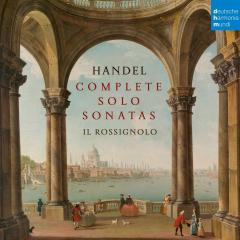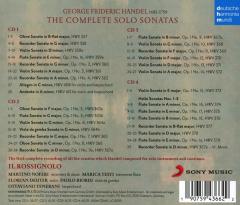In the course of his fruitful life as a composer, George Frideric Handel (1685-1759) not only wrote numerous masterpieces for orchestra, opera and the church. Born in Saxony and later lived in London, the composer also contributed to the world of chamber music with numerous outstanding works. Handel has composed 16 solo sonatas for the recorder, transverse flute, oboe, violin and viola da gamba, whereby there are also revised second editions of some sonatas which still challenge musicology with the question of which version is the original one. For the first time, the Italian early music ensemble Il Rossignolo recorded for DHM the entire solo sonata opus with all its traditional versions and variations.
A total of 27 sonatas and 3 separate movements were recorded in Italy under the direction of harpsichordist Ottaviano Tenerani with Marica Testi (transverse flute), Martino Noferi (recorder), Florian Deuter (violin) and Paolo Biordi (viola da gamba). "These wonderful sonatas with their diverse ensembles, keys, harmonies and forms offer the listener a completely new perspective on the fruitfulness of Handel's aesthetic and poetic expressiveness", explain the musicians of Il Rossignolo about this unique recording project.
The sonatas for solo instrument and basso continuo were written in a period between c. 1710 and c. 1728 and are today known as Handel's Opus 1. Handel had composed most of the sonatas for advanced amateur musicians from the English, but also from the Dutch and French upper classes. Apart from the three-movement "Hanoverian sonatas" HWV 357 and 358, which were probably written for professional musicians, most of the sonatas follow the four-movement model of the "Sonata da chiesa" characterized by Arcangelo Corelli.









